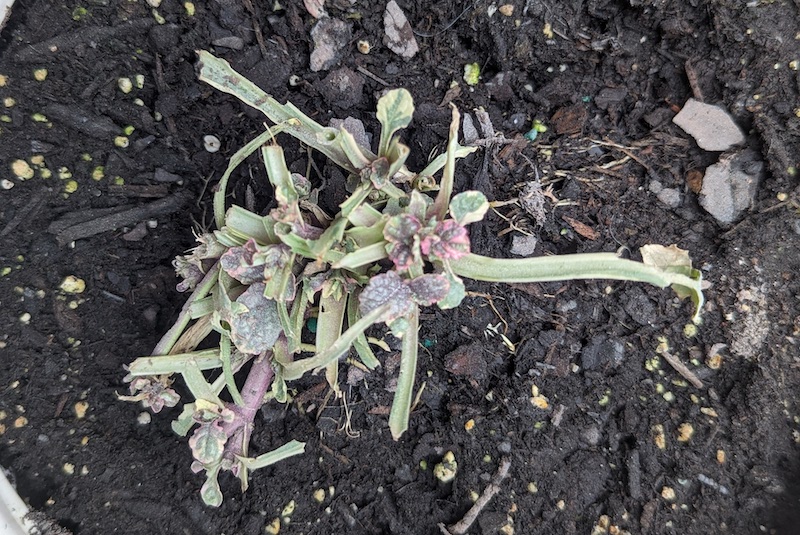While relatively disease resistant, Ajuga, also known as bugleweed, occasionally gets sick. The three most common diseases are crown rot, powdery mildew, and nematode root-knot disease.

Fungi cause crown rot and powdery mildew and can be prevented with proper plant spacing and aeration. Treatment, however, varies depending on the particular disease. Crown rot is more severe and requires the removal of the entire plant and its surrounding soil. Powdery mildew, on the other hand, poses no significant threat unless allowed to progress. You can treat the problem with Neem oil or baking soda solution.
Root-knot disease is caused by parasitic nematodes. You can treat it with bioinsecticides, including soapbark, neem oil, and crab meal, to combat it.
Crown Rot
Crown rot is a disease caused by fungi in the surrounding soil. The only cure is plant removal, so prevention is key. Since heat and humidity support fungal growth, crown rot occurs more commonly during the warmer, wetter months. Pay particular attention to Ajuga during these times to ward off any infections.
Identifying Crown Rot
Since warm, humid conditions encourage fungal growth, look for signs of infection as the temperature and humidity rise. If Ajuga’s stems turn blackish or brownish, examine Ajuga more closely. Are the roots turning brownish-black? If so, then Ajuga is most likely infected with crown rot.
Treating Crown Rot
Properly space Ajuga plants to allow good air circulation. Thin dense clumps, and avoid wetting its foliage and crown. Also, keep ajuga healthy by properly watering it. If Ajuga succumbs to an infection, make sure to remove the affected plant and the surrounding soil. That’s your only option.
Powdery Mildew
Some gardeners worry upon seeing signs of plant disease. If you notice white patches starting to appear on Ajuga’s foliage, don’t panic. This is a common sign of the relatively benign fungal disease, powdery mildew. While the infection detracts from Ajuga’s beauty, it does not pose a significant threat to its overall health. Methods to treat the disease require minimal effort.
Identifying Powdery Mildew
Powdery mildew can appear on the foliage and stems as a white, floury-like substance. The leaves may curl and wilt.
Treating Powdery Mildew
A healthy plant is less likely to be targeted by pests and disease, so properly water, fertilize and prune Ajuga. If Ajuga contracts powdery mildew, don’t worry. While this disease can be lethal, infections are usually mild and harmless. Treat the affected foliage with neem oil or a baking soda solution consisting of a few drops of organic liquid dish detergent, one tablespoon of baking soda, and one gallon of water. Make sure that plants are well watered prior to treatment. Do not apply treatments during high heat or exposure to midday sun. Doing so can damage the plants by scorching the edges of their leaves.
Root-Knot Disease
Root-knot disease is caused by parasitic nematodes that live in the soil and feed on Ajuga’s roots. The parasites suck nutrients from the roots, causing bulges or knots to appear, along with faded, thinning foliage. Root-knot disease threatens the overall health of Ajuga. Treat the disease immediately with an organic product that will not harm beneficial nematodes.
Identifying Root-Knot Disease
If you notice your Ajuga plants turning yellow and thinning, examine the roots for knots. Microscopic roundworms, called Meloidogyne incognita, eat Ajuga’s roots and cause the characteristic knots.

Treating Root-Knot Disease
Organic treatment options for nematode root-knot disease include azadirachtin, saponaria, or geraniol products. Azadirachtin is found in neem oil; geraniol is an alcohol derived from geraniums and is found in essential oils, including rose oil and citronella; and Quillaja saponaria comes from soap bark.
Ajuga Disease Chart
| Disease | Identifying | Treating |
|---|---|---|
| Crown rot | Blackish/brownish stems | Remove and discard diseased plants |
| Powdery mildew | Yellow or white spots on leaves | Proper air circulation |
| Root-knot disease | Knots on roots | Fungicides & air circulation |
Sources:
"Ajuga." Clemson University Cooperative Extension Service. hgic.clemson.edu
"Ajuga." Department Plant Pathology & Microbiology at Texas A&M University. plantdiseasehandbook.tamu.edu
 |
Author Suellen Barnes - Published 11-21-2023 |
